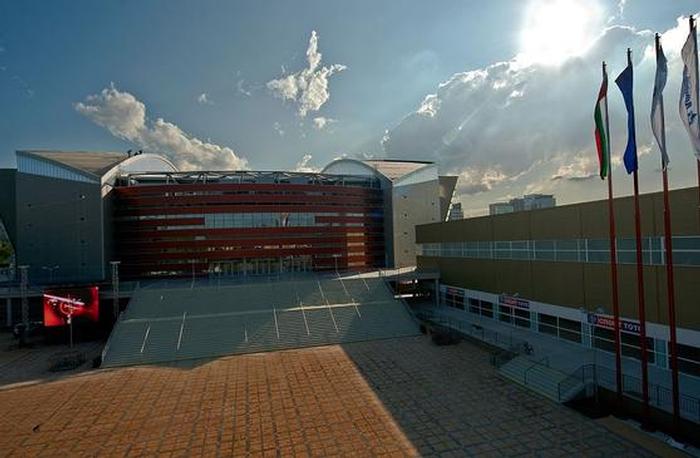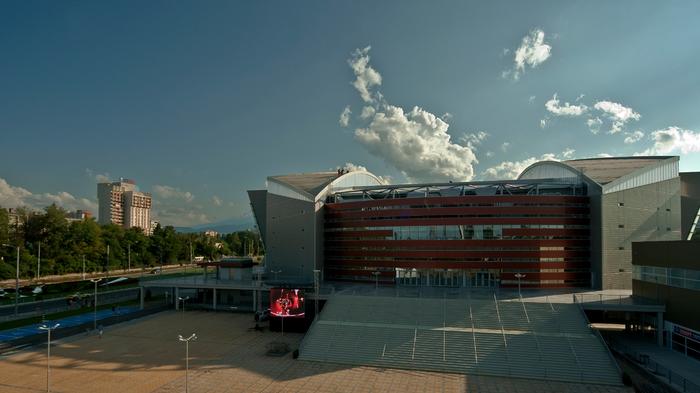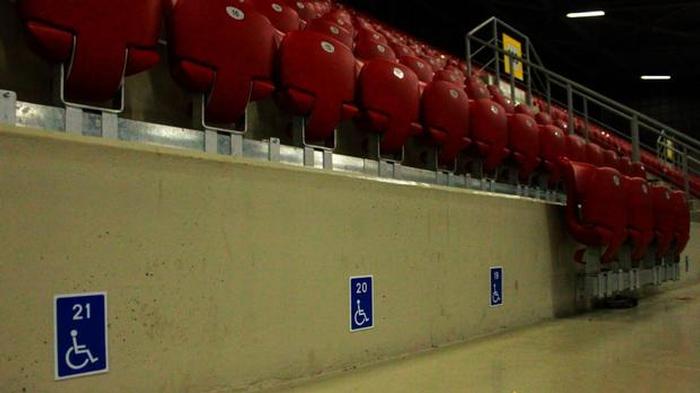Slavka Gancheva - EssayAccess denied?There are many ways to describe my hometown Sofia, capital of Bulgaria. Some argue that it is fascinating, with its own character and curiosities. Others insist that it is fast on the road to becoming just one of many soulless urban nodes the world over. However, in all the descriptions of Sofia I have ever seen, there is one point of view that is always conspicuously missing – that of the people, who in Bulgaria are often dismissed with the convenient label ‘disabled’. In this city struggling to reconcile its new-found European identity with the still present reminders of an outdated political regime, many societal problems that have long been addressed in other countries are only now beginning to surface. Sofia is the chosen setting for this story and our protagonist is forty-seven year old Lena.* By all accounts she is an average Bulgarian woman, married, with two children and a job as an office manager. What sets her apart immediately, however, is the fact that when she was forty, an unfortunate car accident left her bound to a wheelchair. It is the kind of scenario we can read about in the local newspaper – it disturbs us but is quickly forgotten when the daily grind sucks us in. Rarely does it cross our minds that the same tragedy could happen to us. Lena used to think the same but she no longer sees her disability as a tragedy. Now, it is a simple fact of her life. She has gotten used to the looks of sympathy and the lack of simple human understanding in the bureaucratic system in place to distribute financial and medical assistance to disabled people. As a tax-paying, law-abiding citizen of Sofia Lena finds it humiliating to have to have to fill out countless forms, wait out a dozen queues, and undergo a number of medical examinations just to prove that she has the correct percentage of disability to receive a prescribed amount of aid. An amount that has time and again proved insufficient to the complex needs of people with restricted mobility or impaired sight. However, due to the fact that most of them struggle to find employment, many have no choice but to attempt to make ends meet with the modest sum. People in this position frequently find themselves reliant on the aid of family and friends, which is often an unpleasant blow to their self-esteem and determination to lead a normal life. Lena, on the other hand is lucky because she can support herself. She has been doing her job for more than fifteen years and her boss has decided to keep her on, even if it means investing some money to accommodate her needs. The building Lena works in is a modern office block, built in accordance with the new accessibility regulations so she has no trouble entering the premises and taking the lift up to the fourth floor where the firm that employs her is based. However, the journey between her home and workplace proves to be a test of her endurance and will. Like the multitude of disabled people who live in 1960s pre-fabricated panel apartment blocks, the first hurdle she has to face is actually making her way out of the building. Lena has lived on the sixth floor of one of these communist era buildings for the majority of her life. Before her accident she would take little notice of the broken lift and simply take the stairs. However, from the vantage point of a wheelchair the distance between floors one and six might as well be the distance between two cities. As a result, something as simple as going down the stairs becomes a complicated enterprise that involves the help of friends and family, ultimately limiting her personal freedom. It takes Lena and her relatives months to bring all the residents of the building together to pay their share of the repair fee for the lift. Those are difficult times for her as a person, mother, and employee. She feels as if her world is falling apart and there is nothing she can do to prevent it. Making the transition from being a very independent and headstrong individual to being reliant on others in her day-to-day tasks is humbling and frustrating. The experience, however, has made Lena strong and given her a new-found appreciation for the simple things that people often take for granted. The first journey outside her apartment forever changes her perspective of the city she was born and raised in. Her husband brings her wheelchair and then her down the stairs and out in the small garden space in front of the block. He takes a small break to catch his breath and Lena has the moment to take in her surroundings. At first glance nothing seems to have changed, except for the obvious difference in perspective that her seated position offers. The first indication that something is not quite right is the way other residents of the apartment block act when they pass by. They are very cautious in their approach, unsure of how to address the situation without appearing insensitive. The quick conversation takes them away from their comfort zone and it is with some relief that both parties say their goodbyes. After the awkward encounter Lena and her husband decide to take a walk to the nearby park and then pick up some groceries on the way back. The short trip proves quite challenging, however, because the sidewalk is riddled with holes and cracks that they have to go around. Crossing the road is difficult because this particular intersection has not yet been brought up to the nationwide accessibility standards. The transition between the sidewalk and the street is only possible because Lena’s husband lifts up the wheelchair. If she had tried to manage on her own she could have easily lost her balance and hurt herself. On their way the couple encounter yet another obstacle – the last stretch of the sidewalk they have to walk along has been taken over by cars, leaving no room for maneuvering the wheelchair. In fact, all other pedestrians choose to walk out on the street rather than try and navigate the small pockets of space left by the parked vehicles. Despite the danger, Lena and her husband wait for a lull in the traffic and manage to go around the cars and finally, reach their destination. The park is lovely and the two enjoy their time in the fresh air. It is, however, with some sadness that they notice most of the alleys are either too narrow or paved with materials that hinder the progress of the wheelchair. Instead of taking their usual walk, they decide to spend some time in a nearby café and relax. Lena likes the hum of activity around her and for a blissful moment life seems back to normal. Half an hour later, however, yet another barrier stands between her and the life she used to lead. The small grocery store tucked away in a small space on the ground floor of her block has become inaccessible for her. It is one of those pop-up stores with barely enough room for the stock that have become so popular in the high-density prefabricated developments that they are now seen as a part of the local culture. Needless to say there is no ramp to allow disabled access since there are ‘only’ five steps. However, the real problem is that the door is simply not wide enough to let the wheelchair through. If Lena wants to shop by herself she will have to go the big supermarket ten blocks away. In order to get there she will have to take a bus but there are very few accessible public transport vehicles in the capital and none pass close to home. It is a vicious cycle that Lena does not know how to break. The following years pass under the shadow of her disability, which she constantly struggles against. Her work helps keep her grounded and she becomes involved with several initiatives meant to raise public awareness on the lack of accessibility in Sofia. It is a slow and painstaking process trying to interest people in her life story, to convince the government to look at the city from her perspective, to fight for the changes she wants to see in the world around her. However, Lena is convinced that it is worth it and is happy to see some of the progress, even if it is mostly due to EU regulations taking effect rather than the general public taking a stand for disabled people. After all, life is starting to look much better for her. She goes to work everyday using the newly built accessible underground, though it sometimes takes a stranger’s kindness to help her bridge the gap between the platform and the train. In her free time, she has also visited the recently refurbished National Gallery and enjoyed the artwork by the great Bulgarian painter Vladimir Dimitrov-Maystora. Most of all, she is excited to be able to attend concerts or big games with the rest of her friends and family in the new Sports Arena “Armeets”. Lena had always felt like she was holding back her relatives from having fun but now she can enjoy a family outing without worrying about her disability. Despite the frustration she feels at the fact that she can count the number of accessible public event spaces in Sofia on the fingers of one hand, she is determined not to let it get in the way of leading an exciting and fulfilling life. Lena is just one of the faces of Bulgaria’s disabled community. Her story offers only a glimpse into the life challenges these people have faced and continue to face day after day. Limited mobility, impaired sight or hearing, chronic diseases each leave their mark on an individual’s life. The current accessibility conditions in Sofia are such that it takes great determination and will to keep fighting for the right to a normal life, uninhibited by physical barriers. Historically, the voice of the disabled people in Bulgaria has fallen on deaf ears, leading to much frustration and pain for the disadvantaged, their families, and friends. It is not that Bulgarians are so cruel as to ignore the suffering of others but that until the past couple of years little exposure had been given to the major problems of those with serious physical impairments. As a social issue, this lack of information has proved crippling to the progress of Sofia as a modern European capital that ought to embrace all of its citizens. So long have the problems been avoided that there is even no unified account of the number of people affected by disabilities. However, there is a very strong sense of community that exists among disabled people and they have managed to band together to form groups of interest, organize events, and initiate campaigns. Unfortunately, even if those initiatives receive media attention such as the labeling of inaccessible public buildings with ‘Access Denied’ stickers, there is very little in terms of tangible results. If there is a particularly loud public outcry, officials will install a ramp or a lift as a form of peace offering. These piecemeal solutions do not contribute much to the overall improvement of the built environment for people with disabilities. A comprehensive approach that addresses the problems of accessible public transportation and facilities would be more appropriate to the context of a capital city. As the flagship of the accessibility movement that has recently been gaining momentum, the Arena “Armeets” starts to address some of the above-mentioned issues. It takes into consideration the latest criteria on accessibility laid down by the EU and offers a community space that brings together people from all walks of life. An important point the designers of the arena took into account was how people with mobility difficulties would reach it. Therefore, there are now several bus links that lead to the building, all serviced by vehicles with a platform that can be lowered to allow easier access and at least two wheelchair places. In addition, there are 42 parking spaces clearly marked for use by disabled people and a designated stair-free route to the main hall.** Lifts can be used to reach upper levels of the arena and all door handles are at an appropriate height. In each section of the main hall there is a row for people with wheelchairs and staff is available to help direct people with impaired vision or hearing to their seats. However, the arena is not only for one-off events – it is an immersive experience. There are numerous sports training facilities inside, most of which are available for use by people with disabilities. As a result sports classes, events, and competitions can be hosted in a space that does not discriminate against the physical limitations of people. The Arena “Armeets” has brought Sofia that little bit closer to integrating its disabled community. It has given much hope that the situation is starting to change and that the public is finally taking notice of the problems of people with disabilities. Living a normal and fulfilling life should not be considered a privilege but a right and while Sofia will owe its disadvantaged citizens for a long time to come there is at least hope that change is happening and that social issues will no longer be ignored.
*A collection of stories gathered from the forums of the Bulgarian National Association of Disabled People has been used to create this character in an attempt to give a viable description of the struggles of a disabled person without violating their privacy. **Information taken from the official "Arena Armeets" site: http://arenaarmeecsofia.com/ Additional Help and InformationAre you in need of assistance? Please email info@berkeleyprize.org. |
|



